Related Research Articles

In angiosperms, a hypanthium or floral cup is a structure where basal portions of the calyx, the corolla, and the stamens form a cup-shaped tube. It is sometimes called a floral tube, a term that is also used for corolla tube and calyx tube. It often contains the nectaries of the plant. It is present in many plant families, although varies in structural dimensions and appearance. This differentiation between the hypanthium in particular species is useful for identification. Some geometric forms are obconic shapes as in toyon, whereas some are saucer-shaped as in Mitella caulescens.
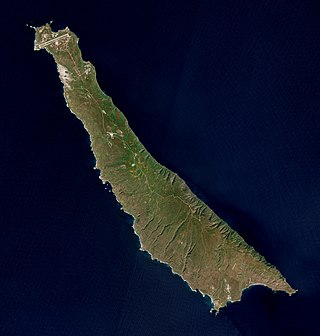
San Clemente Island is the southernmost of the Channel Islands of California. It is owned and operated by the United States Navy, and is a part of Los Angeles County. It is administered by Naval Base Coronado. It is 21 miles (34 km) long and has 147.13 km2 (56.81 sq mi) of land. The 2018 census estimates 148 military and civilian personnel reside on the island. The city of San Clemente in Orange County, California is named after the island.

Pinus sabiniana, with vernacular names including towani pine, foothill pine, gray pine, bull pine, and digger pine, is a pine endemic to California in the United States. Some sources discourage using the name "digger pine," considering it pejorative.

Heteromeles arbutifolia, commonly known as toyon, is a common perennial shrub native to extreme southwest Oregon, California, and the Baja California Peninsula. It is the sole species in the genus Heteromeles.

Chilopsis is a monotypic genus of flowering plants containing the single species Chilopsis linearis. It is known commonly as desert willow or desert-willow because of its willow-like leaves, but it is not a true willow – being instead a member of the catalpa family.
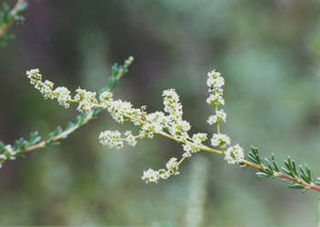
Adenostoma fasciculatum, commonly known as chamise or greasewood, is a flowering plant native to California and Baja California. This shrub is one of the most widespread plants of the California chaparral ecoregion. Chamise produces a specialized lignotuber underground and at the base of the stem, known as a burl, that allow it to resprout after fire has off burned its stems. It is noted for its greasy, resinous foliage, and its status as one of California's most iconic chaparral shrubs.

Holodiscus discolor, commonly known as ocean spray or oceanspray, creambush, or ironwood, is a shrub of western North America.

Frangula californica is a species of flowering plant in the buckthorn family native to western North America. It produces edible fruits and seeds. It is commonly known as California coffeeberry and California buckthorn.

Nepenthes glabrata is a tropical pitcher plant endemic to Sulawesi. The species grows in open, high forest at elevations of 1600 to 2100 m. It produces dainty, colourful pitchers reaching only a few centimetres in height. These traps are red speckled on a yellowish background, giving them a "hand painted" appearance.
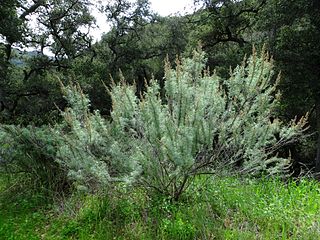
Artemisia californica, also known as California sagebrush, is a species of western North American shrub in the sunflower family.

Prunus ilicifolia is native to the chaparral areas of coastal California, Baja California, and Baja California Sur. as well as the desert chaparral areas of the Mojave desert.

Banksia bipinnatifida is a species of shrub that is endemic to Western Australia. It is a prostrate shrub with a lignotuber, an underground stem, only a few divided leaves, large cream-coloured to pale yellow flowers and large fruit.

Eucalyptus goniocalyx, commonly known as long-leaved box, olive-barked box or bundy, is a species of small to medium-sized tree that is endemic to southeastern Australia. It has rough, fibrous or flaky bark, lance-shaped to curved adult leaves, flower buds in groups of seven, white flowers and cup-shaped, cylindrical or barrel-shaped fruit.

Quercus dumosa is a species of plant in the family Fagaceae, belonging to the white oak section of the oak genus (Quercus). This tree goes by the common names coastal sage scrub oak and Nuttall's scrub oak.
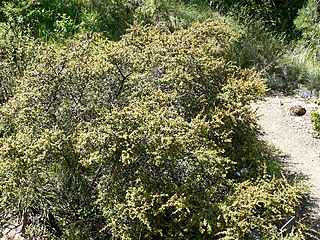
Rhamnus crocea, the spiny redberry, is a species of plant in the family Rhamnaceae. There are two subspecies: Rhamnus crocea subsp. crocea and Rhamnus crocea subsp. pilosa. It is native to California, Arizona, and Baja California.

Ceanothus crassifolius is a species of flowering shrub known by the common name hoaryleaf ceanothus. This Ceanothus is found throughout the coastal mountain ranges of the southern half of California, and its range extends into Baja California.
This glossary of botanical terms is a list of definitions of terms and concepts relevant to botany and plants in general. Terms of plant morphology are included here as well as at the more specific Glossary of plant morphology and Glossary of leaf morphology. For other related terms, see Glossary of phytopathology, Glossary of lichen terms, and List of Latin and Greek words commonly used in systematic names.
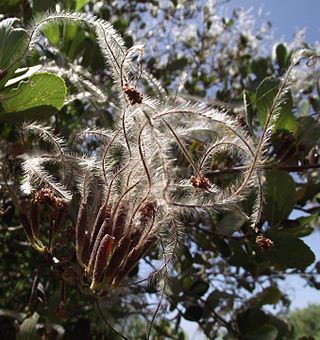
Cercocarpus betuloides is a shrub or small tree in the rose family. Its common names include mountain mahogany and birch leaf mountain mahogany The common name "mahogany" comes from the hardness and color of the wood, although the genus is not a true mahogany.

Leionema rotundifolium, is a dense shrub with needle-shaped stems and pale lemon to white terminal flowers. It is found in New South Wales and Queensland.
References
- ↑ Annette J.G. Wilson, Alexander S. George, Anthony E. Orchard (2001) Flora of Australia, Published by ABRS/CSIRO ISBN 0-643-06720-5
- ↑ M.R. Cheek and M.H.P. Jebb (1999) Nepenthes (Nepenthaceae) in Palawan, Philippines. Kew Bulletin54(4): 887–895. doi : 10.2307/4111166
- ↑ Willis Linn Jepson and James C. Hickman (1993) The Jepson Manual: Higher Plants of California, Published by University of California Press, 1400 pages ISBN 0-520-08255-9
- ↑ C. Michael Hogan (2008) Toyon (Heteromeles arbutifolia), GlobalTwitcher, ed. Nicklas Stromberg "Toyon (Heteromeles arbutifolia ) - - GlobalTwitcher.com". Archived from the original on July 19, 2009. Retrieved August 19, 2009.
- ↑ Joseph Dalton Hooker (1879) The Flora of British India, Great Britain India Office, Published by L. Reeve
- ↑ George Massee (1895) British Fungus-flora: A Classified Text-book of Mycology
- ↑ Laurence Urdang, Alexander Humez and Howard G. Zettler (1982) Suffixes and Other Word-final Elements of English, Contributor Laurence Urdang, Published by Gale Research Co.